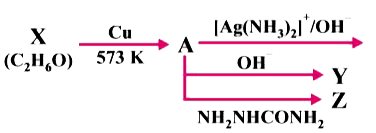At the end of glycolysis, X is the net energy gain from one molecule of glycose via Y, but there is also energy stored in the form of Z. Identify X,Y and Z.
XYZ1ATPOxidative phosphorylationNADH+H+
XYZ2ATPsOxidative phosphorylationNADH+H+
XYZ1ATPSubstrate level phosphorylationFADH2
XYZ2ATPsSubstrate level phosphorylationNADH+H+
The correct Answer is:D
To solve the question, we need to identify three components related to glycolysis: X, Y, and Z.
1. Understanding Glycolysis: Glycolysis is the metabolic pathway that breaks down one molecule of glucose into two molecules of pyruvate. This process occurs in the cytoplasm of the cell and is anaerobic, meaning it does not require oxygen.
2. Identifying X (Net Energy Gain): At the end of glycolysis, the net energy gain from one molecule of glucose is in the form of ATP. Glycolysis produces a total of 4 ATP molecules, but since 2 ATP molecules are consumed in the initial steps, the net gain is 2 ATP.
- X = 2 ATP
3. Identifying Y (Type of Phosphorylation): The ATP that is produced during glycolysis is generated through a process called substrate-level phosphorylation. This is a direct method of synthesizing ATP by transferring a phosphate group from a substrate to ADP.
- Y = Substrate-level phosphorylation
4. Identifying Z (Stored Energy): In addition to ATP, glycolysis also produces NADH (nicotinamide adenine dinucleotide), which is a carrier of electrons and stores energy in the form of high-energy electrons. This NADH can later be used in the electron transport chain to produce more ATP.
- Z = NADH + H⁺
In conclusion, the identified components are:
- X = 2 ATP (net energy gain)
- Y = Substrate-level phosphorylation (the process)
- Z = NADH + H⁺ (stored energy)
Summary:
- X: 2 ATP
- Y: Substrate-level phosphorylation
- Z: NADH + H⁺
- X = 2 ATP (net energy gain)
- Y = Substrate-level phosphorylation (the process)
- Z = NADH + H⁺ (stored energy)
- X: 2 ATP
- Y: Substrate-level phosphorylation
- Z: NADH + H⁺
Topper's Solved these Questions
Similar Questions
Knowledge Check
- Question 1 - Select One
At the end of glycolysis, X is the net energy gain from one molecule of glycose via Y, but there is also energy stored in the form of Z. Identify X,Y and Z.
AXYZ1ATPOxidative phosphorylationNADH+H+BXYZ2ATPOxidative phosphorylationNADH+H+CXYZ1ATPOxidative phosphorylationFADH+H+DXYZ2ATPOxidative phosphorylationFADH+H+ - Question 2 - Select One
 . Identify X,A,Y,Z. AA-methoxymethane, X-ehtanol,Y-ethanoic acid, Z-semicarbazideBA-ethanol, X-ethano,Y-but -z-enal, Z-semicarbazone.CA-ehtanol,X-Acetaldehyde, Y-Butanone, Z-HydroazoneDA-Methoxymethane, X-ethanoicacid, Y-acetate ion and Z-Hydrazine.
. Identify X,A,Y,Z. AA-methoxymethane, X-ehtanol,Y-ethanoic acid, Z-semicarbazideBA-ethanol, X-ethano,Y-but -z-enal, Z-semicarbazone.CA-ehtanol,X-Acetaldehyde, Y-Butanone, Z-HydroazoneDA-Methoxymethane, X-ethanoicacid, Y-acetate ion and Z-Hydrazine. - Question 3 - Select One
Net gain of ATP from one molecule of glucose in glycolysis, is
A3B6C8D2
Determinant form of (x−y)(y−z)(z−x)
View SolutionThe net gain of energy, from one molecule of sucrose in aerobic respiration, is
View SolutionThe net gain of energy from one gram molecule of glucolose during aerobic respiration is
Net gain of ATP in prokaryotes is a high as 300 parts per millionView SolutionThe pathway of respiration common in all living organisms is x––, it occurs in the y– and the products formed are two molecules of Z––. Identify X,Y and Z in the above paragraph and select the correct answer.
View SolutionA metal X reacts with aqueous NaOH solution to form Y and a highly inflammalbe gas. Solution Y is heated and CO2 is poured through it. Z precipitates out and Na2CO3 is formed. Z on the heating gives AI2O3. Identify X,Y and Z.
X Y ZView Solution



